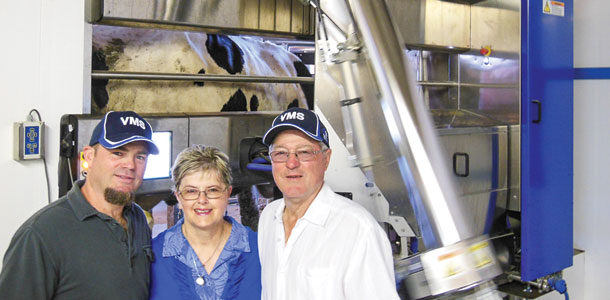For the Austin family of southwest Washington, robots were the answer to a needed milking center upgrade that would carry them into the future. Ron is the fifth generation on this organic dairy farm. His parents, Jim and Janie, remain a staple part of the operation, which includes 120 rotationally grazed milking cows and an additional 300 head of youngstock.
When their double-seven herringbone parlor was in need of replacement a few years ago, the family started looking at their options. After touring a robot dairy in Oregon, Austin realized this was not a far-out technology, but rather one that he could implement to meet his dairy’s needs.
“I imagined there would be a big robot walking around milking cows,” he jokes. “But when I saw the robots, I thought we could make them work here.”
After a few tours and a trip to Canada to look at more of these units, they obtained financing and began drawing up plans. The freestall barn, primarily used in the winter during the non-grazing season, was in good condition, so they decided to utilize their existing facility.
The Austins completed the retrofit on their own, doing the construction over a period of a few months. The first robot was installed in May, followed by the second in June. During this transitioning time, they kept half of the old parlor running.
Now, nearly two years later, Austin feels they have adjusted to their new, technological way of dairying, though it certainly came with its learning curves. One of those was finding cleaning supplies that met organic standards.
Another has been dealing with cows whose rear teats are too close together, as the robots sometimes have difficulty locating and attaching the unit. They have since tweaked their breeding program to emphasize more robot-friendly traits like teat placement.
The switch from conventional to an automated milking system not only relieved the physical labor of milking but also added a new level of excitement around Austin Farm as dairy producers from across the country are eager to see how an organic, rotational-grazing herd makes robots work.
“I wanted to do something that was a challenge and a bit of a risk,” Austin says. “We were one of the first ones to do it, so we have learned a lot.”
Since converting to robots, what has changed about the way you manage your dairy? What has not changed?
Ron: Robots have allowed us to do things that in the past we didn’t have time to get done. What hasn’t changed is that it is still farming and it is still hard work. You don’t automatically switch over into a 9-to-5 way of life, but it does make it more flexible.
Jim: It gives us time to do more management than we did before, but what hasn’t changed is that we still have to have someone around the robots all the time, just like when we were milking twice a day in the parlor. We don’t necessarily have to be right there in the barn, but someone needs to be close by to make sure things are clean and working properly.
What factors went into your decisions of how to design your barn?
Jim: We did it this way [fit robots into existing facility] because we had a nice barn to begin with. Financially, for us to build an entirely new barn, it would have been tough to make it work. Plus, for us where we live, there would be lots of permits involved in building a new barn.
Also, we went with a controlled-flow system. Once the cows come up to the barn, they cannot leave until they have been milked. We have three separation gates: one as we leave the parlor in case we need to put a cow in the catch pen for herd check or breeding; one that exits to the pasture [during grazing season only]; and a main separation gate to either go back to the parlor or up to eat.
Ron: Our robots are raised up like a raised parlor. When we have fresh cows or cows with rear teats too close together that the machine has a hard time attaching, we run them in a group and set the robot so we can put the units on manually.
What is your favorite feature of the new facility?
Ron: I really like seeing how calm the cows are with this system. They were calm before, but you can really see the calmness now. They are used to flowing on their own. Our cows take care of us. It’s our duty to do our best to take care of them.
Jim: The way that robot arm works is really fantastic. It’s amazing how fast it works to spray and wash teats.
If you could go back and rebuild knowing what you know now, what would you do differently?
Ron and Jim: We would have saved a portion of the old parlor to bring in fresh cows. We may add one on someday for this purpose.
What are three points of advice you would give to someone considering robots for their dairy?
Ron and Jim: We were one of the first in our area to do this, so we learned a lot.
1.It’s better to build from the ground up than to retrofit, but this worked best in our case.
2.Be prepared. Talk to as many people as you can.
3.Go out and see how other people set up their robots, then go back and figure out how to make them work for you, whether you are building new or using an old facility. Build around your own situation. PD
PHOTO
Ron Austin (left) and his parents, Janie and Jim, run a 120-cow organic dairy near Oakville, Washington. They replaced a double-seven herringbone parlor with two DeLaval VMS units two years ago.Photo by Mike Dixon.

Peggy Coffeen
Editor
Progressive Dairyman







